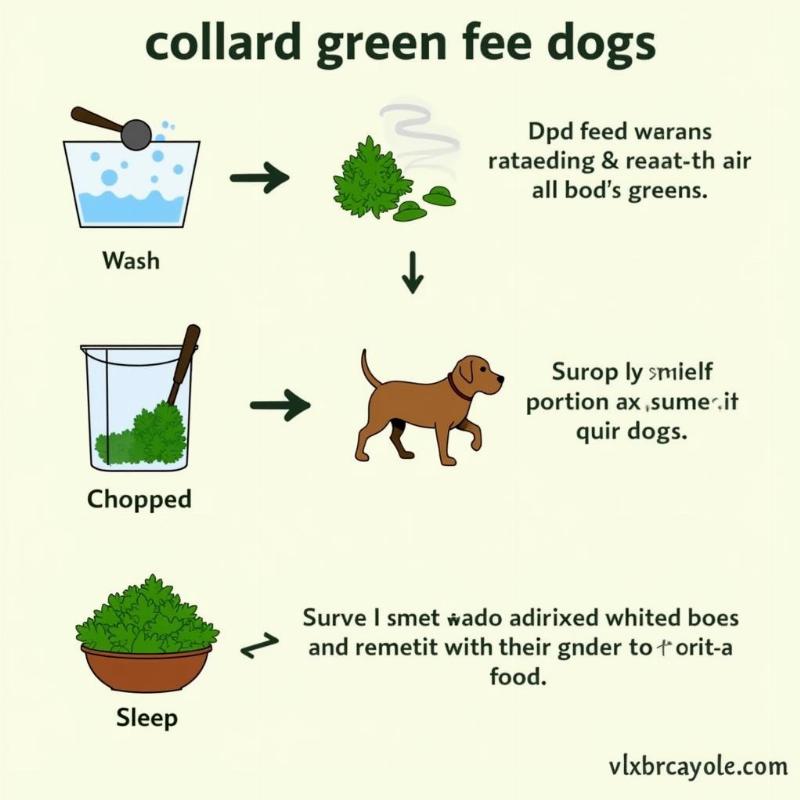Collard greens, a staple in Southern US cuisine, are often touted for their health benefits for humans. But what about our furry friends? Is collard greens good for dogs? The short answer is yes, but with a few important caveats. While collard greens can offer some nutritional value, they should be fed in moderation and prepared correctly to avoid potential health issues.
The Nutritional Perks (and Pitfalls) of Collard Greens for Dogs
Collard greens are packed with vitamins A, K, and C, as well as fiber and antioxidants. These nutrients can contribute to a dog’s overall health, supporting healthy vision, blood clotting, and immune function. Fiber can aid in digestion, and antioxidants help protect against cell damage. However, collard greens also contain calcium oxalate, which can contribute to the formation of bladder stones in susceptible dogs. Furthermore, like spinach and kale, collard greens contain goitrogens, which can interfere with thyroid function if consumed in large quantities.
Serving Collard Greens Safely to Your Canine Companion
So, how can you safely incorporate this leafy green into your dog’s diet? The key is moderation and proper preparation. Always cook collard greens thoroughly before offering them to your dog. Raw collard greens are difficult to digest and can cause gastrointestinal upset. Steaming or boiling is the best method, as it helps reduce the goitrogens and makes the greens easier for your dog to digest. Avoid adding any seasonings, especially salt, onions, or garlic, which can be toxic to dogs.
 How to Cook Collard Greens for Dogs
How to Cook Collard Greens for Dogs
Can Dogs Eat Raw Collard Greens?
While technically dogs can eat raw collard greens, it’s generally not recommended. Raw collard greens are much tougher for dogs to digest than cooked greens and can cause gas, bloating, and diarrhea. can dogs eat raw collard greens discusses this in more detail. Additionally, the goitrogens present in raw collard greens are more potent and pose a greater risk to thyroid function.
How Much Collard Greens is Too Much?
As with any new food, introduce collard greens gradually to your dog’s diet, starting with a small amount and monitoring for any adverse reactions. Even cooked collard greens should only be given as an occasional treat, not a staple food. Too much can lead to digestive issues or contribute to bladder stones in predisposed breeds. If you notice any signs of digestive upset, such as vomiting or diarrhea, discontinue feeding collard greens and consult your veterinarian.
Are There Better Alternatives to Collard Greens for Dogs?
While collard greens offer some nutritional benefits, other vegetables are generally considered safer and more beneficial for dogs. Consider offering small amounts of cooked carrots, green beans, or sweet potatoes as healthier alternatives. calcium rich foods for nursing dogs offers alternative options for specific needs. You can also explore dog food brands like Orijen Six Fish that incorporate a balance of nutrients without the risks associated with certain vegetables. six fish orijen dog food can provide more insights.
Conclusion: Collard Greens for Dogs – Proceed with Caution
Collard greens can be a healthy treat for dogs in moderation, but it’s crucial to prepare them correctly and monitor your dog for any adverse reactions. Always consult your veterinarian before introducing any new foods to your dog’s diet, especially if they have pre-existing health conditions. While collard greens offer some nutritional value, remember that they shouldn’t replace a balanced, complete dog food.
FAQ
- Can puppies eat collard greens? It’s best to avoid giving collard greens to puppies due to their sensitive digestive systems.
- What should I do if my dog eats too many collard greens? Monitor your dog for any signs of digestive upset or discomfort and contact your veterinarian if necessary.
- Can I give my dog collard green stems? It’s best to stick to the leafy parts of the collard greens, as the stems can be tougher to digest.
- Are there any dog breeds that should avoid collard greens altogether? Dogs prone to bladder stones, such as Dalmatians and Miniature Schnauzers, should avoid collard greens.
- Can I mix collard greens with my dog’s regular food? Yes, you can mix a small amount of cooked, chopped collard greens with your dog’s food.
- Are frozen collard greens okay for dogs? Yes, frozen collard greens can be used, but ensure they are thawed and cooked thoroughly.
- Can I give my dog canned collard greens? It’s best to avoid canned collard greens, as they often contain added salt and other ingredients that may be harmful to dogs.
Beautdogs.us is your premier source for all things dog-related in the USA. We offer expert advice on dog breeds, care, and lifestyle, empowering both new and seasoned dog owners to provide the best possible care for their furry companions. From breed-specific guides to nutritional advice and product recommendations, Beautdogs.us is your trusted resource for a happy, healthy dog. Contact us today for personalized guidance and support! Email: [email protected], Phone: +1 501-555-7529.